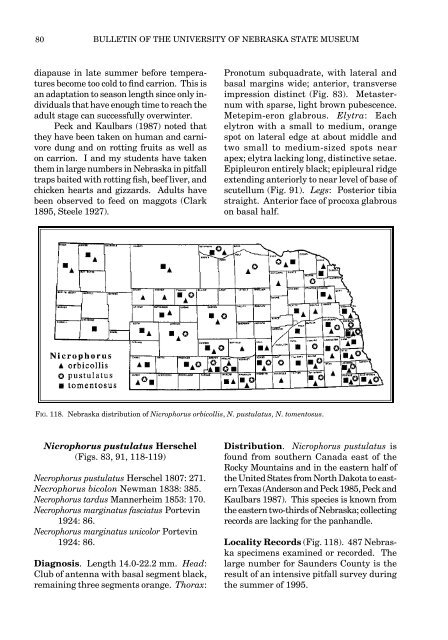Download full text - University of Nebraska State Museum
Download full text - University of Nebraska State Museum
Download full text - University of Nebraska State Museum
You also want an ePaper? Increase the reach of your titles
YUMPU automatically turns print PDFs into web optimized ePapers that Google loves.
80<br />
BULLETIN OF THE UNIVERSITY OF NEBRASKA STATE MUSEUM<br />
diapause in late summer before temperatures<br />
become too cold to find carrion. This is<br />
an adaptation to season length since only individuals<br />
that have enough time to reach the<br />
adult stage can success<strong>full</strong>y overwinter.<br />
Peck and Kaulbars (1987) noted that<br />
they have been taken on human and carnivore<br />
dung and on rotting fruits as well as<br />
on carrion. I and my students have taken<br />
them in large numbers in <strong>Nebraska</strong> in pitfall<br />
traps baited with rotting fish, beef liver, and<br />
chicken hearts and gizzards. Adults have<br />
been observed to feed on maggots (Clark<br />
1895, Steele 1927).<br />
Pronotum subquadrate, with lateral and<br />
basal margins wide; anterior, transverse<br />
impression distinct (Fig. 83). Metasternum<br />
with sparse, light brown pubescence.<br />
Metepim-eron glabrous. Elytra: Each<br />
elytron with a small to medium, orange<br />
spot on lateral edge at about middle and<br />
two small to medium-sized spots near<br />
apex; elytra lacking long, distinctive setae.<br />
Epipleuron entirely black; epipleural ridge<br />
extending anteriorly to near level <strong>of</strong> base <strong>of</strong><br />
scutellum (Fig. 91). Legs: Posterior tibia<br />
straight. Anterior face <strong>of</strong> procoxa glabrous<br />
on basal half.<br />
Fig. 118. <strong>Nebraska</strong> distribution <strong>of</strong> Nicrophorus orbicollis, N. pustulatus, N. tomentosus.<br />
Nicrophorus pustulatus Herschel<br />
(Figs. 83, 91, 118-119)<br />
Necrophorus pustulatus Herschel 1807: 271.<br />
Necrophorus bicolon Newman 1838: 385.<br />
Necrophorus tardus Mannerheim 1853: 170.<br />
Necrophorus marginatus fasciatus Portevin<br />
1924: 86.<br />
Necrophorus marginatus unicolor Portevin<br />
1924: 86.<br />
Diagnosis. Length 14.0-22.2 mm. Head:<br />
Club <strong>of</strong> antenna with basal segment black,<br />
remaining three segments orange. Thorax:<br />
Distribution. Nicrophorus pustulatus is<br />
found from southern Canada east <strong>of</strong> the<br />
Rocky Mountains and in the eastern half <strong>of</strong><br />
the United <strong>State</strong>s from North Dakota to eastern<br />
Texas (Anderson and Peck 1985, Peck and<br />
Kaulbars 1987). This species is known from<br />
the eastern two-thirds <strong>of</strong> <strong>Nebraska</strong>; collecting<br />
records are lacking for the panhandle.<br />
Locality Records (Fig. 118). 487 <strong>Nebraska</strong><br />
specimens examined or recorded. The<br />
large number for Saunders County is the<br />
result <strong>of</strong> an intensive pitfall survey during<br />
the summer <strong>of</strong> 1995.
















